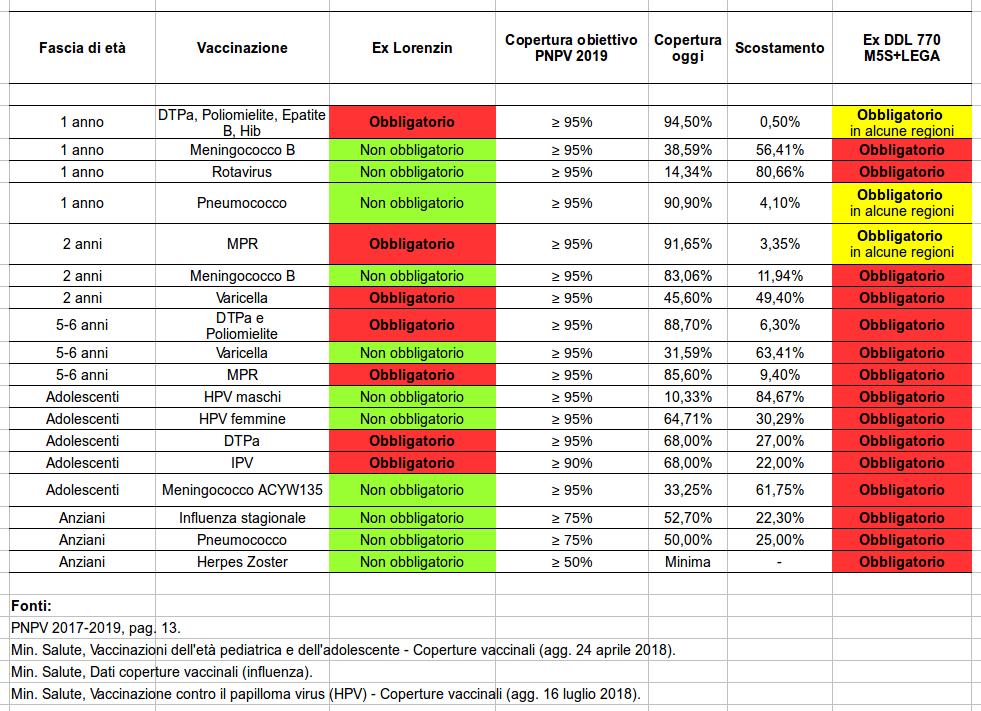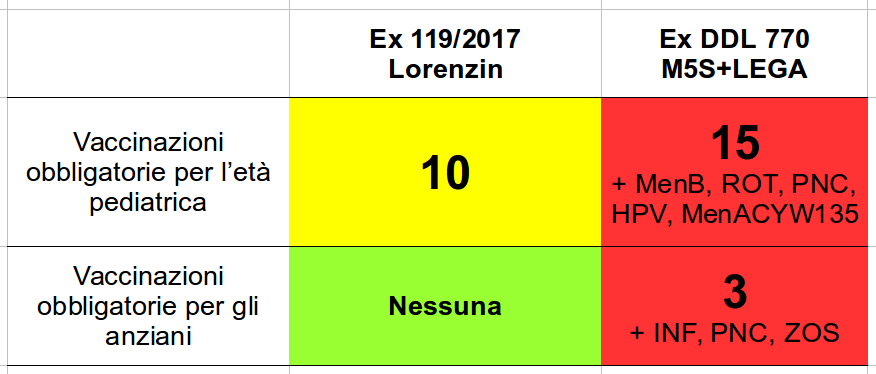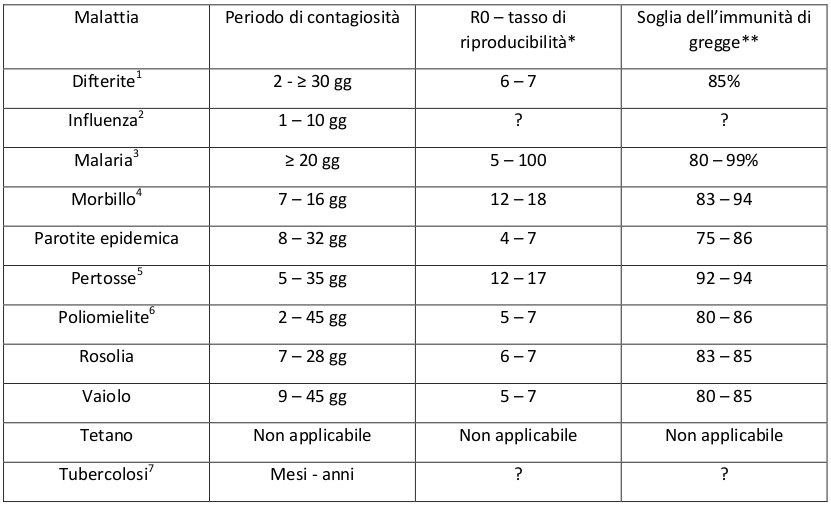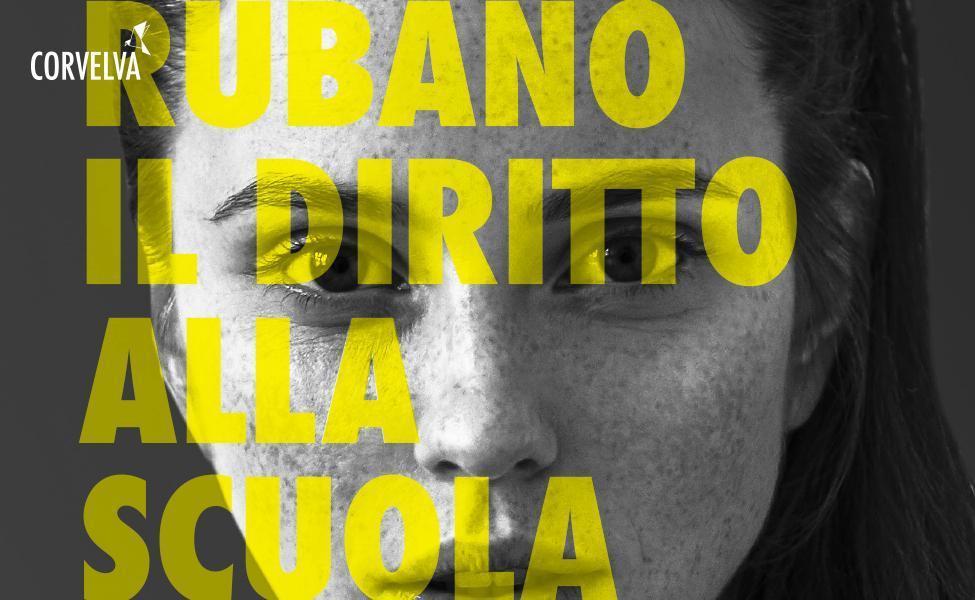Regret Lorenzin?
Yes it can. Anatomy of a technology
ALSO GET INFORMED ABOUT # DDL770

Article taken from the Blog "The Pedant"of October 05, 2018
In the appendix toprevious article and in the thematic furrow of the protest - useful or not - that prompted me to close the blog, I add here some analytical and contextual considerations on the aforementioned pending bill no. 770 co-signed by the group leaders Stefano Patuanelli (M5S) and Maximilian Romeo (League) and members of the Senate Hygiene and Health Commission Pierpaolo Sileri (M5S) Maria Domenica Castellone (M5S) and Sonia Fregolent (League) bearing "Vaccination prevention provisions". The text, presented on August 7, is assigned to the 12th Standing Commission (Hygiene and Healthcare) of the Senate in the drafting office. This means that any amendments to the proposal will be evaluated and approved within the Commission alone, reserving the vote for the final text on the Assembly. The discussion started on October 2nd.
It has already been documented and deplored the fact that the "flexible obligation" regulated by the proposal "would exceed" Lorenzin's obligation in an entirely augmentative sense, just as a powerful sports car would overcome a utility vehicle on the highway: that is, it aims to extend it in applications and in sanctions to the point of making it potentially universal. Be careful not to jeopardize the abomination of preventive compulsory health care - therefore not motivated by urgency - and mass, the DDL n. 770 fully accepts it ratio raising it up all age groups ("For certain birth cohorts") in the event of "impairment of group immunity" (Article 5, paragraph 1). In these cases, the "pecuniary administrative sanction from € 100 to € 500" (ibi, paragraph 3) would add the possibility of excluding defaulters from the "attendance of educational institutions of the national education system" (ibi, paragraph 4) and therefore also from compulsory and high schools, going where the previous government had not dared to go. Since, finally, "the objectives to be achieved throughout the national territory" would be those set by the National Vaccine Prevention Plan (PNPV) adopted "on the proposal of the Minister of Health, after consulting the Higher Institute of Health" (art. 2), the number of vaccinations to be imposed by means of an obligation would no longer necessarily be limited to the ten provided for by the Lorenzin Law, but could also extend to other infectious diseases according to the priorities set by the technicians and the coverage levels registered.
The new DDL would thus outclass (not "overcome") the coercion ex Lorenzin by expanding it in every possible direction: a) of the age groups and therefore of the number of people involved, b) of the applicable sanctions and c) of the vaccinations subject to the obligation . Having said this, the writer's wish can only be one of his silent and premature death, and who can never leave the desks of those who conceived it. An even more necessary outcome if the intention to further intensify the Lorenzini taxation with the measures is measured adverse positions to the obligation already expressed by the Minister of Health in office and, even more, by the secretary of the League Matteo Salvini, who also in a recent rally reiterated how sacrosanct the right to go to school is for all children. Because a country that denies this right is not civil». Having added, however, that "there are two of us in government", it remains to be asked why among the signatures at the bottom of a proposal that explicitly denies the right to "attend school institutions in the national education system" that of his group leader in the Senate also appears.
If a revocation of the text was not made possible by the circumstances, the abnormal provision of suspension from schools and kindergartens would at least be urgently removed: both in order not to attack with certainty to a constitutional right-duty (art. 34) on the basis of both feared and remote eventualities, both to emerge the claws of a mechanism of coercion and discrimination that is unprecedented in republican history. However desirable in the alternative, this result would still leave the plant intact a profoundly wrong and dangerous law in its scientific and legal foundations, whose precedent would open the door to the possibility of abuses that, little or nothing benefiting public health, would further endanger social cohesion and trust in institutions. Analyzing the ways in which this would happen is also useful in the desired hypothesis of a reversal of the decision makers' direction, to draw a more general warning on the evils of a "technocratic" law applied to a concrete case.
Like any law of "technical" inspiration, the DDL n. 770 prefigures an «algorithmic» and linear steering mechanism. The provision rests on the double information pillar of a five-year PNPV containing the calendar, objectives and recommendations regarding vaccine prevention, and the new National Vaccine Registry where the data relating to the vaccination status of the population converge. By crossing the two information flows, the health authorities should be able to monitor the correspondence of vaccination behaviors to the objectives set in near-real time and with "granular" precision according to age, gender, geographical location, clinical conditions, etc. to intervene "surgically" in situations of failure to reach the targets. It would be theoretically possible, for example, to activate the HPV obligation for male preadolescents only in a province, or the anti-flu obligation for elderly subjects in a region only.
The "extraordinary intervention plans" involving the obligation would be launched - the only really positive news - "on the proposal of the Minister of Health after deliberation by the Council of Ministers, after consulting the Higher Institute of Health ... by decree of the President of the Republic », That is, through a political decision and a process that is not exactly" lean "nor much less automatic. This should guarantee a margin of political discretion which would however remain subject to the "harsh law" of the number, disciplinarily integrating the "external constraint»Where the political bodies decide the like but not the thing, and a parameter only symbolically related to the objective - such as the deficit public spending threshold, or the deficit / GDP ratio - arises as a totem for legislative action. The flaw of method underlying this monofactorial and mechanical vision, closer to the dynamics of a video game that the complexity of a biological and mass phenomenon is punctually reflected in its tools.
National vaccination prevention plan: the external constraint
In the proposal examined here, the vaccination coverage targets dictated by the PNPV would be the sole source of legislative intervention, which would thus be deprived of the power to deliberate on each individual case by accepting wider scientific criteria and also non scientific, according to multiple sources of law. The technocratic tabe reveals itself here in the illusion of "sterilizing" the fallibility of the political decision-making process subjecting it to a criterion that is considered to be a-political, drawing origin and legitimacy from itself and from "evidence". But this is simply not possible. The elaboration of objectives for the diffusion of a prophylaxis, and further upstream the very fact of electing those goals e that prophylaxis, itself reflects a worldview and a hierarchy of priorities and interests. In 2015, the famous epidemiologist Vittorio Demicheli denounced for example on the pages of the Sole 24 Ore that «the calendar shown in the [then] National vaccination plan is the faithful copy of the" calendar for life "sponsored by the pharmaceutical industries». The story, net of any judgment, reminds us that the dialectics and the uncertain ones stolen from politics inevitably reappear on the higher planes of technology which, in making its decision, becomes itself politics in spite of its paludation.
In terms of merit, many distracted observers appreciated the "common sense" of proposal no. 770 without, in the least, knowing either the ambitious requirements of the PNPV that should arise by law, or the situation in which this should take place. Scrolling through the text in force today, one would in fact realize that the application of the obligation to "significant deviations ... such as to generate the risk of compromising group immunity" would trigger such a dizzying increase in inoculations to make the Lorenzino dictate pale. We sketch below a simulation by crossing the most recent data on coverage and recommendations of the PNPV 2017-2019:

The simulation takes on normal case scenario, that is, in which a government in office complied with the provisions of art. 5. Of course, the recommendations of the new PNPV may introduce a gradualness of the thresholds, but this would move the problem without solving it. Or again, that an executive will only partially activate the extraordinary plans justified by the deviations, but this would transform the person's right to study and inviolability into a mere concession that derogates from the law for "goodness" - always revocable and always subject to appeal - someone's.
In short, the "flexibility" of the obligation in question is revealed to be that of an empty bladder that adapts itself elastically to its content. While it promises to flex to the "circumstances", the "situation" or - as some candid still believes - the "epidemics", it actually follows the profile of a technical recommendation which, in expanding the objectives to the maximum, expands the sheath to the maximum legislation and taxation that adheres to it. So we find out that mandatory childhood and adolescent vaccines could rise from the current ten to fifteen, and those for the third age from zero to three, without saying what would fall to "health professionals" whose separate mention (art. 5, paragraph 1) seems to suggest that they would be subject to additional and dedicated obligations.

Group immunity: the policy of the numerino
According to the theory of group immunity (or "flock"), the circulation of an infectious agent within a community can be stopped if a sufficient percentage of its members are immunized against that agent. Net of other qualitative recommendations, the "objectives" of the PNPV that should inform the extraordinary interventions of the executive coincide precisely with the percentage thresholds of vaccination coverage to avoid the "compromise of group immunity". The protection mechanism against infectious diseases prefigured by the DDL thus boils down to monitoring a single parameter by marrying a vision rigidly one-dimensional of the problem that lends itself to more than one criticism.
Flying over the scientific diatribes about the determination of the thresholds, the rates and the duration of the seroconversions and the persistence of epidemic phenomena for some diseases even in excess of the safety thresholds (such as , promising, , promising o , promising), the most obvious problem is of political nature. That you have to reach for all antigens the coverage maxim recommended in the literature (in the PNPV it is all obsessive ≥ 95%, but see table below) and not rather modulating the objectives according to the presence, probability and danger of each disease, it is a decision that cannot escape the democratic debate. Vaccination is first and foremost - and in some cases exclusively - a useful tool for personal protection. Farne always e automatically trigger the "epic" goal of suppressing diseases in the country or in the world underlies, too when this is scientifically proven, an exclusively political project which, due to the proportions of its ambition and the drastic means it claims, must be shared and discussed on a case by case basis, involving the wider democratic audience, not relegating it to the tables of a technical document.

Group immunity thresholds (from Paul EM Fine. Herd immunity: history, theory, practice, Epidemiol. Rev. 1993. 15; 2: 265-302).
On the merits, the choice to subordinate actions of prevention and sanction of unprecedented severity to a single parameter should be corroborated by a strong and clear correlation between the levels of vaccination and the infections. But this correlation, at least to the coverage levels already reached, is far from iron, for example if the Italian regional data for some diseases cross. The measure of contagions should therefore be investigated and contained by extending the analysis to one plurality of factors to produce strategies articulated and targeted according to each reality. Of all this, however, there is no trace in the DDL under discussion, which is satisfied instead of imposing, with unpublished tools of coercion, the achievement of a number One-Size-Fits-All promising to subordinate an uncertain health advantage to certainty of the sacrifice of freedom, constitutional rights and social inclusion of millions of people.
The "numerino policy" that becomes a totem, the failures of which have already been observed in other famous public decisions ((in primis) those regarding public budget objectives), betrays the ultra-reductionist and "cybernetic" will to disqualify complex phenomena reducing them to easily understandable variables, thus reducing the politician to "guardian of the number", replaceable prodrome of an artificial intelligence .
National vaccination registry: the will to power
Many observers welcomed the establishment of a "vaccination registry" which the DDL under discussion inherits in full from the Lorenzin decree (art. 4-bis), changing its name to «national vaccination registry» (AVN, art. 4). The AVN constitution will serve to "monitor the implementation of vaccination programs on the national territory" by registering "the subjects vaccinated and to be vaccinated, the subjects referred to in Article 1, paragraphs 2 [immunized as a result of natural disease] and 3 [ exempted or postponed for health reasons] of this decree, as well as the doses and times of administration of the vaccinations carried out and any side effects ».
It should be noted that the data on vaccination coverage by place and cohort of birth have already been known to the central administration for years (, promising those of childhood and adolescence), as well as possible adverse reactions e cases of diseases subject to surveillance. Once fully operational, and provided it is well designed, an instrument such as the new AVN could therefore facilitate "the development of indicators" (ibi, paragraph 3) and "the collection and exchange of information with European ... international bodies" and national (ibi, paragraph 4), but would not add much in terms of information. If the problem were the inefficiency of the collection and transmission of data in charge to local administrations, it would instead be easy to predict, in analogy with other sectors already invested by the fury of portals and "big data", that the introduction of new charges and procedures would entail other bureaucratic burdens, and therefore inefficiencies.
However, the fundamental problem is another. While promising to be a register of health data to improve public health, the AVN would actually collect a list of "subjects" (name, surname, tax code) to monitor not so much the clinical conditions, but their adherence to the "programs vaccines on the national territory "and, therefore, the reasons for their possible non-adhesion. In other words, it would serve to monitor the fulfillment of a legal obligation - albeit «flexible», it has been seen that it miusra - overcoming the uncertain residuals of communications between entities. This, given its overall mild statistical utility, would bring the AVN closer to one animal health police tool thanks to which it would be possible to identify and sanction in real time not already certain categories of individuals, but each individual resident at the vaccination act.
In the context of an obligation that promises, subject to changes, to expand considerably beyond what is already imposed by the law in force - in the order of millions of new doses every year - and the extent of the sanctions envisaged, the adoption of this instrument seems to promote a further and decisive shift from information and sharing policies to those of one coercion without escape, opening the door to a potentially blind and deaf medicalization that is potentially endless because it is no longer balanced, even in its risks, by the criticism and objection of citizens and operators.
The "will to power", the last stage of technocracy, shifts the whole weight of political action to the side of surveillance and repression to free it from the resistance of a popular base identified as "enemy of progress" and not already, according to the Constitution, supreme instigator of that action. It thus tends to a dream ontologically totalitarian government where it is possible to effortlessly identify and remove every single exception or out of tune thanks to the capillarity of the electronic tools on the net: from the control of internet communications to the automatic detection of conversations, from the filing or blocking of «cashless» expenses to widespread video surveillance, from tracking GPS integration of databases to access the details of each one's life «with a click». These tools, due to the enormous power they concentrate in the hands of very few, and in a context already irresistibly suited to the introduction of ever new coercions, should be limited to applications of maximum urgency and necessity only. Frankly, this does not seem to be the case with a new national vaccination registry.
But it depends on your point of view. And from the purposes.





